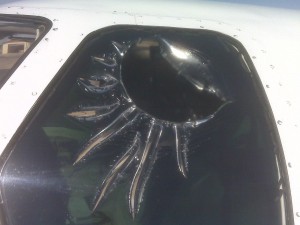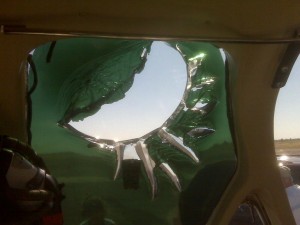Looking for ways to reduce heat while maintaining visibility in your private jet or business jet aircraft? Use caution before attempting to add any screens or window tint films to your aircraft windows, as they can cause extreme damage to your transparencies. As the Original Equipment Manufacturer of aircraft windows, Lee Aerospace has advice on dealing with the summer season and the effect of heat on aircraft windows.
Should You Use Sunscreens and Window Tint on Aircraft Windows?
 The short answer is, no. When the forecast calls for high summer temperatures, you may be tempted to keep the inside of your cabin as cool as possible. But using materials not designed for your aircraft may cause a bigger headache for your private or corporate aircraft maintenance team in the future.
The short answer is, no. When the forecast calls for high summer temperatures, you may be tempted to keep the inside of your cabin as cool as possible. But using materials not designed for your aircraft may cause a bigger headache for your private or corporate aircraft maintenance team in the future.
How Heat Affects Aircraft Windows
Most of the aircraft windows manufactured for pressurized aircraft are constructed from a material known as stretched acrylic. This is part of the manufacturing process whereby the acrylic material is heated to a pliable melting temperature over 230° and pulled in all directions (stretched) to about three times its original size. The acrylic is then cooled, machined, and polished to correct optical standards.
This process greatly increases strength and rigidity making it ideal material for aircraft windows. However, the acrylic will try to shrink back to its original shape when it gets too hot. That means your aircraft windows can actually melt!
Sunscreen & Window Tint Options to Avoid on Aircraft Windows
In order to avoid mistakes like this, we would like to point out a couple of things to avoid using on your aircraft windows:
 Automotive Window Tint
Automotive Window Tint
While it may seem like a great idea at first, automotive window tint was not designed for aircraft windows. The problem with using this kind of product is it could cause your windows to absorb excessive heat, overheating the stretched acrylic to the point of shrinking back to its original size. If the window is clamped in it could fall out of the aircraft. Some windows are fastened in and when the material starts to shrink all it can do is tear. This would be tough to explain to your boss when he comes back to the plane to go home and sees a hole in the cockpit window big enough to stick your head through.
Another problem with using automotive window tint on aircraft windows is that it is designed to be applied over glass. The adhesive that is used on the tint could have an adverse effect on the acrylic leading to premature failure.
“Cling-On” Sunscreens
Many pilots use these to block the sun because they can be moved as needed and generally work great. Just remember these stick-on sun screens are designed for temporary use only. We strongly recommend that they be removed when the aircraft is parked to prevent overheating the acrylic.

A Better Alternative: Keep Aircraft Cabins Cool with CoolView Windows
CoolView aircraft windows are manufactured with an advanced thin metallic composite barrier system specifically designed for aircraft transparencies. Engineered for added comfort with cooler cabin temperatures, appearance and the protection of your aircraft interior. The CoolView windows reduce harmful infrared rays by 82% and UV rays by 99%, in turn reducing the heat inside of your aircraft. Lee Aerospace makes CoolView replacement windows for a range of aircraft:
